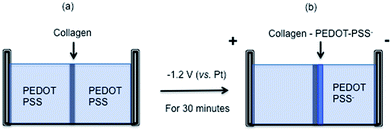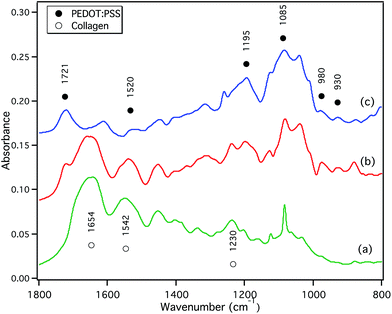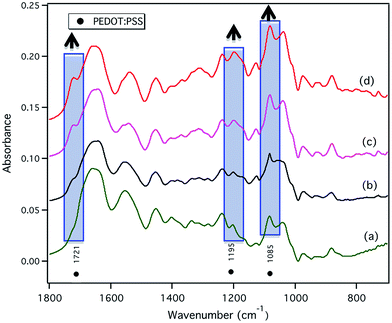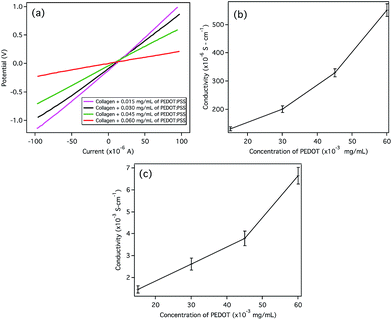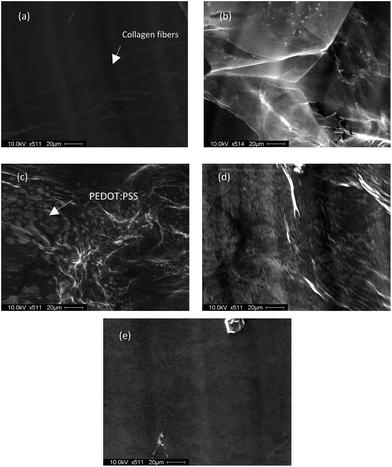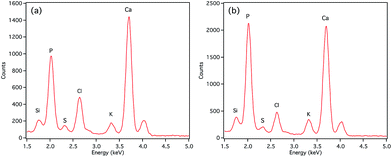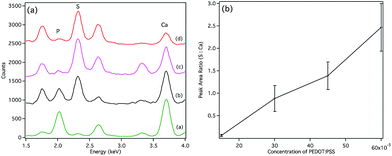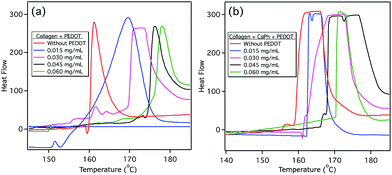Electrically conducting collagen and collagen–mineral composites for current stimulation†
M. Ramesh Kumar and
Michael S. Freund‡
*
University of Manitoba, Winnipeg, MB R3T 2N2, Canada. E-mail: msfreund@fit.edu
First published on 25th June 2015
Abstract
Bifunctional films with higher electrochemical and bioactive properties have many promising applications including tissue engineering, drug delivery, nerve regeneration and bone healing. Since bone possesses natural bio-potential and electromechanical properties, the idea of utilizing small electrical pulses to induce bone-tissue growth has been explored in recent decades. Studies have revealed that electric stimulation (in the order of μV) has positive effects on the osteogenesis, and enhances the mineral formation in osteoblast-like cells. However, the mechanisms behind these effects are not well understood. Electric stimulation is generally performed through the implantation of metal electrodes that need to be removed after the treatment. This sometimes requires surgery that can lead to complications including infection and damaging newly formed bone-tissue. Therefore, in the search for new implant materials that are bioactive (allowing different cells to grow over it) and electrically conductive (to perform electrical stimulation), a composite material has been synthesized by integrating the electro-active properties of the conducting polymer (poly-3,4-ethylenedioxythiophene, doped with polystyrene sulfonate, PEDOT:PSS) with the biological properties of collagen (protein, which is present in the cornea) and collagen–calcium phosphate membranes (which mimics the composition of bone). It is shown that by varying the concentration of PEDOT:PSS, the composite (collagen–PEDOT:PSS) or the hybrid (collagen–hydroxyapatite–PEDOT:PSS) membrane could be altered to be highly biocompatible and highly electrically conductive.
1. Introduction
In recent years, researchers have shown significant interest in collagen and collagen-based materials for developing artificial implant/repair materials like artificial bone, corneas, wound-care tissue, dermis and arterial replacement tissues. Collagen is a family of proteins that accounts for ∼25% of protein content in the whole body. It is abundant in fibrous tissues like skin and tendons, and is also a major component in blood vessels and the cornea. Collagen is the main protein in the native extracellular matrix (ECM) in mammals, and thus is a suitable scaffold material for creating artificial substitutes for various damaged or diseased tissues and organs since collagen is widely known for strongly promoting cell proliferation.1 It is also used as an extracellular matrix for many cell culture studies to assess how different kinds of cells interact with the microenvironments surrounding them during growth and development. Therefore, there is a great need for the development of new collagen-based biocompatible materials for tissue repair and replacement that can have a positive interaction with the host tissue.Research to develop an artificial cornea has received much attention since the cornea acts as a transparent window to the eye, and any disease or damage to it directly affects the function of the eye or leads to vision loss. Millions of people are affected by corneal diseases and are waiting for corneal transplant surgery. Since it is not possible to replace the cornea in every case, it is necessary to develop artificial corneas. Since the stroma, the main component of the cornea, is made up of collagen, research into the development of collagen-based biocompatible materials is critically important to the field.
In addition, there is an urgent demand for bone healing materials because conventional bone replacement metals and alloys, while mechanically strong, do not usually stimulate cell growth. Bone is a complex composite comprised of mineral and proteinaceous components. Although collagen is the main matrix constituent in bone, there is evidence that non-collagenous proteins also contribute to calcium phosphate mineralization. Therefore, there is a great need for the development of new collagen–calcium phosphate based biocompatible materials for tissue repair and replacement that can have a positive interaction with the host tissue. Rather than attempting to mimic the complex in vivo bone regeneration process, there has been considerable scientific effort devoted to the development of in vitro methods to produce collagen–calcium phosphate composites that can be used to enhance bone healing. The electrochemically-assisted synthesis, based on isoelectric focusing, offers an expedient way to make robust collagen membranes and collagen–calcium phosphate composites with controlled mineral phase.2
In this research work, we aim to develop a hybrid material or a polymeric blend, by combining a protein (collagen), biomineral (calcium phosphate) and a conducting polymer (poly-3,4-ethylenedioxythiophene, PEDOT). In general, blends of collagen and a conducting polymer can find several interesting applications such as developing many useful materials that require some level of electrical conductivity including nerve regeneration and promoting osteo-conductivity.3,4 There have been few reports in which conducting polymers such as polypyrrole,5–7 polyaniline,3 and PEDOT5,8,9 have been incorporated onto collagen and other biomaterials for various biomedical applications including nerve regeneration, neurite outgrowth10 and bone mineral growth.11 Results of these studies indicate that various cells including osteoblast in culture are sensitive to electrical stimulation, resulting in enhancement of cell growth and/or biomineralization.11
Earlier work has shown that the electrochemically aggregated collagen–calcium phosphate composites are structurally similar to bone,2,12 highly biocompatible (allow various cells to grow over them),13 and keep the cells in quiescent state (a necessary requirement if the material is to be used for implant purpose).14 Incorporating a conducting polymer on to these materials would provide a means for electrical stimulation to enhance both bone-tissue and mineral growth. Moreover, incorporating a conducting polymer directly onto a biomaterial such as collagen can reduce the use of metallic electrodes that are currently used for electrical stimulation. Metallic electrodes are often considered as poor long-term implants, and modifying them with conductive polymer coating has been getting great attention since it can provide enhanced tissue–electrode interface and much better lifetime.15 As a result, it is reasonable to expect that these hybrid materials will reduce the pain and healing duration for patients, due their better biocompatibility, biodegradability and enhanced cell growth.
However, incorporating a conducting polymer onto the robust collagen and collagen–calcium phosphate composites poses several challenges. Though there are some reports in which protein molecules are incorporated onto conducting polymers either as dopant16 or as a composite-reinforcement6 using electrochemical methods, there are major challenges for incorporating a conducting polymer onto collagen–calcium phosphate. Generally collagen–calcium phosphate is either aggregated by isoelectric focusing2,17 (in which pH gradient is formed to focus the molecules in the electrochemical cell) or by electrolytic deposition.18 If the conducting polymer–collagen–calcium phosphate material is to be formed using isoelectric focusing, it requires much higher potential for water splitting in order to create pH gradient, at which the conducting polymer may not be stable. Therefore, it will be tricky to find an apt electrochemical method to aggregate the proposed hybrid composite materials, either simultaneously or layer by layer. PEDOT was chosen for this work because of its ease of preparation, very good electrical conductivity and its in vitro compatibility with various cells.
Challenges in the production of such composites also include phase selectivity of the mineral component (to control reactivity and solubility) and adhesion between the protein, conducting polymer and mineral component (for enhanced mechanical stability). Since the electrochemically assisted mineral precipitation can yield several different calcium phosphate phases depending on electrolyte composition, a strong preference needs to be given to form carbonated hydroxyapatite, the mineral phase that is most similar to the one found in natural bone. Apart from synthesizing the composite material, characterizing their structural, thermal and electrical properties need to be performed to verify if the material is structurally similar to bone, thermally stable to withstand body temperature and electrically conductive to perform stimulation.
2. Experimental work
2.1. Electrochemical aggregation of collagen and collagen–calcium phosphate
Electrochemical aggregation of collagen was carried out using the ‘isoelectric focusing’ method, described in detail earlier.17 A two-electrode round-bottomed cylindrical cell was used for the electrochemical aggregation of all collagen and collagen–calcium phosphate based membranes. When a relatively large potential (enough to split the water) is applied through the electrodes, the redox reactions of water generate H+ and OH− ions near the anode and cathode respectively, thus creating a pH gradient in the electrochemical cell. When type-I collagen monomer (PureCol Bovine Collagen, Advanced Biomatrix, USA, final concentration of 0.06 mg mL−1) is exposed to this pH gradient, the amphoteric collagen loses it charge at the place where the pH matches its isoelectric point, and forms a membrane anchoring to the container wall (Fig. S1b†). Two Pt wires, separated at 2 cm were used as working and counter electrodes, and a potential of 8 V (vs. Pt counter) was applied using a CH Instruments 760C potentiostat for 1 h (Fig. S2a†). Aqueous NaOH (Sigma Aldrich) solution was used to bring the initial pH of the collagen electrolyte to 7. It has been reported that increasing the duration of applied potential increases the fibril–monomer ratio and stiffness of the formed collage membrane, and the stiffest membrane was obtained by applying 8 V for 1 h.19In order to deposit a calcium phosphate layer over the collagen membrane, different concentrations of CaCl2 and KH2PO4 (Sigma Aldrich) were added on the anode and cathode sides respectively (Fig. S3a†). When a potential is applied, Ca2+ ions tend to move towards cathode while the oppositely charged phosphate ions move towards anode, resulting in formation of calcium phosphate layer over the collagen membrane. The calcium phosphate layer and precipitate forms only in the basic side of the cell, as the calcium phosphate readily dissolves in acid (Fig. S3b†).2,12
2.2. Electrochemical incorporation of a conducting polymer onto collagen and collagen–calcium phosphate
After formation of collagen membranes, an aqueous conducting polymer solution, containing poly-3,4-ethylene dioxythiophene-polystyrenesulfonate (PEDOT:PSS, Clevious FET, 3–4 weight percent of solid PEDOT:PSS particles dispersed in water, purchased from Heraeus Precious Metals, PA, USA) was added in the electrolyte (at different volumes). Then cyclic voltammetry (Fig. S2b†) was performed in order to determine the electro-active potential of the PEDOT:PSS. When the PEDOT:PSS active potential is applied (−1.2 V vs. Pt counter), the negatively charged PEDOT:PSS molecules move towards anode. This ultimately results in the polymer molecules being trapped in the pores of collagen membrane (at the center of the electrochemical cell) and/or forming a layer over the membrane depending the concentration of the PEDOT:PSS in the electrolyte (Fig. 1b). Four different concentrations (0.015, 0.030, 0.045 and 0.060 mg mL−1) of PEDOT:PSS were used to alter the quantity/ratio of PEDOT:PSS in the collagen membranes. Once the membrane formed, it was removed from the solution using tweezers and placed on a glass slide for FTIR and conductivity measurements, or on indium tin oxide (ITO, Delta Technologies, Rs: 4–8 Ω) coated glass slides for SEM, or on a DSC pan for DSC thermograms. The same method was employed to incorporate various concentration of PEDOT:PSS onto collagen–calcium phosphate membranes as well (Fig. 2).2.3. Characterization
The effective incorporation of PEDOT:PSS onto collagen membrane was characterized using FTIR. Once the films were dried on a glass slide, they were scrapped off, ground finely with KBr and made into 15 mm diameter pellets. FTIR measurements were carried out on Thermo Nicolet Nexus 870 instrument in transmittance mode. All spectra were recorded between 4000 to 400 cm−1 at the resolution of 4 cm−1 and 32 scans were performed to obtain each spectrum.A four-point probe head (SP4-62045TBS, Lucas Signatone Corp, CA), connected to a Solatron Electrochemical Interface (SI 1287) was used to measure the conductivity of all samples. After the electrochemical aggregation process, the membrane was taken out, placed on a glass slide and used immediately for the conductivity measurement in its hydrated form. In the four-point probe measurement, current is applied between the end electrodes (1 and 4) and the resulting potential drop due to the resistance of the material is continuously monitored between the middle (2 and 3) electrodes. For all measurements, the samples were scanned between −0.1 mA to +0.1 mA at the rate of 0.01 mA s−1. The measurements were carried out at three different locations in a sample, and three similarly grown samples were used for each category (collagen and collagen–calcium phosphate with four different concentrations of PEDOT:PSS). From the I–V plot, the bulk conductance of the films can be calculated as
 | (1) |
In order to measure the thickness of the sample, the weight of the membrane was measured as soon as it was taken out from the electrolyte. Then an image of the membrane was captured through a camera, and ImageJ software was used to measure the surface area of the irregular shaped membrane. By knowing surface area and mass of the membrane, the thickness can be calculated by assuming the membrane density as 1 g cm−3 since all these membranes contain more than 90% water in their hydrated state. All these membranes were assumed to contain more than 90% of water since the measured weight of dried membrane was always less than 10 percent of that of hydrated membrane in all cases. The calculated thickness of the hydrated collagen and collagen–PEDOT:PSS membranes ranged from 0.11 to 0.16 cm, and the thickness for the collagen–calcium phosphate–PEDOT:PSS samples were between 0.16 and 0.21 cm.
A scanning electron microscope (Cambridge Instruments, Stereoscan 120) was used to image the morphology of the collagen, collagen–PEDOT:PSS and collagen–calcium phosphate–PEDOT:PSS samples to investigate how PEDOT:PSS was incorporated. Carbon was coated on pure collagen and collagen–calcium phosphate to make the surface sufficiently conducting, while the PEDOT:PSS incorporated samples were used as such. 10 kV was used as acceleration voltage for all samples, and each sample was scanned on at least 10 different locations at two different magnifications.
Energy Dispersive X-ray (EDX) analysis was also carried out using Cameca SX100 Electron Probe Microanalyzer to differentiate the phases of calcium phosphate and to determine the incorporation level of PEDOT:PSS onto collagen–HA. 15 kV was used for acceleration and each sample was probed on at least five different locations to calculate the average PEDOT:PSS level incorporation.
The effect of incorporation of PEDOT:PSS onto collagen membranes on its denaturation temperature (Td) was measured with a differential scanning calorimeter (PerkinElmer Diamond DSC). All samples were dehydrated on glass slide for 3 h, and approximately 2 mg of the sample was used for each experiment. The samples were scanned between 0 °C to 500 °C in both directions at the rate of 10 °C min−1 under N2, and three samples prepared in similar way were used in each case.
3. Results and discussions
3.1. FTIR spectra
Fig. 3 shows the FTIR spectra of pure collagen, pure PEDOT:PSS and PEDOT:PSS incorporated collagen. The peptide bond vibrations at 1654, 1542 and 1230 cm−1 are mainly from amide I, II and III of collagen.20 The most intense amide I bond at 1654 cm−1 can be associated with the peptide carbonyl stretching (–C![[double bond, length as m-dash]](https://www.rsc.org/images/entities/char_e001.gif) O), and the amide peak at 1542 cm−1 proves the presence of helical structure of the collagen.21 The FTIR spectrum of PEDOT:PSS is shown in Fig. 3c. The sample was prepared by adding a drop of PEDOT:PSS solution with KBr, and dried in oven at 100 °C for an hour before making it into pellet. The peak at 1085 cm−1 mainly arise from C–O–C bond stretching in ethylenedioxy group, and the peak at 1195 is due to the S
O), and the amide peak at 1542 cm−1 proves the presence of helical structure of the collagen.21 The FTIR spectrum of PEDOT:PSS is shown in Fig. 3c. The sample was prepared by adding a drop of PEDOT:PSS solution with KBr, and dried in oven at 100 °C for an hour before making it into pellet. The peak at 1085 cm−1 mainly arise from C–O–C bond stretching in ethylenedioxy group, and the peak at 1195 is due to the S![[double bond, length as m-dash]](https://www.rsc.org/images/entities/char_e001.gif) O vibration of PSS. The broad peak at ∼1520 cm−1 is assigned to thiophene ring stretching. The small vibrations at 980 and 930 cm−1 are mainly due to thiophene C–S stretching.22 The FTIR spectrum of composite material (Fig. 3b) shows the presence of all three amide peaks from collagen, C–O–C ethylenedioxy bond stretching of PEDOT:PSS (at 1195 and 1085 cm−1) and thiophene C–S stretching (at 980 and 930 cm−1), indicating the presence of both collagen and PEDOT:PSS. The PEDOT:PSS peak of 1520 overlap with the collagen amide II peak at 1542 cm−1.
O vibration of PSS. The broad peak at ∼1520 cm−1 is assigned to thiophene ring stretching. The small vibrations at 980 and 930 cm−1 are mainly due to thiophene C–S stretching.22 The FTIR spectrum of composite material (Fig. 3b) shows the presence of all three amide peaks from collagen, C–O–C ethylenedioxy bond stretching of PEDOT:PSS (at 1195 and 1085 cm−1) and thiophene C–S stretching (at 980 and 930 cm−1), indicating the presence of both collagen and PEDOT:PSS. The PEDOT:PSS peak of 1520 overlap with the collagen amide II peak at 1542 cm−1.
Fig. 4 shows the FTIR spectra of collagen–PEDOT:PSS composite materials that were synthesized using four different concentrations of PEDOT:PSS in the electrolyte. All spectra clearly indicate that the intensity of PEDOT:PSS vibration peaks at 1721, 1195 and 1085 cm−1 increase with the concentration of PEDOT:PSS in the electrolyte, while the three-amide peaks of collagen (1654, 1542 and 1230 cm−1) stay same. This confirms that the quantity of collagen in the final composite material is same since the collagen aggregation procedure was identical for all membranes. At the same time, increasing the concentration of PEDOT:PSS in the electrolyte makes the electrolyte solution more conductive, thus resulting in higher incorporation of PEDOT:PSS onto the collagen membranes even though the applied potential and duration were same in all cases.
FTIR spectra of collagen–calcium phosphate membranes prepared at three different concentrations of CaCl2 and KH2PO4 are shown in Fig. S4.† Since calcium phosphate can be synthesized in its various phases including hydroxyapatite, brushite or tricalcium phosphate, it has been shown earlier that any phase can be obtained by altering the concentration of calcium and phosphate salts in the electrolyte.2 As seen in Fig. S4,† the higher concentration of calcium and phosphate salts (0.025 M and higher) yield brushite (P–O stretching in the PO3 fragment at 1136, 1061 & 986 cm−1, P–OH stretching at 874 cm−1 and P–O bending at 662, 576 & 527 cm−1)23,24 and the lowest concentration (0.01 M) yields the much preferred carbonated hydroxyapatite phase (phosphate ν1 at 1034 cm−1, phosphate ν4 at 600 and 560 cm−1 and carbonate ν2 at 879 cm−1).25
According to literature,26 brushite phase of calcium phosphate forms in acidic environment, while the stable apatite forms in more neutral conditions. During the electrochemical aggregation of collagen–calcium phosphate, initially the collagen monomer electrolyte was brought into neutral pH by adding required quantity of NaOH. Therefore, when lower concentration of CaCl2 and KH2PO4 (0.01 M) were used, we can expect the electrolyte pH to be more in neutral, thus forming hydroxyapatite. However, when the concentration of CaCl2 and KH2PO4 is higher (≥0.025 M), during the application of electrochemical potential, KH2PO4 splits into K+ and (PO4)3− ions in order to form KCl and calcium phosphate, which will ultimately leave more H+ ions in the electrolyte. These excess H+ ions would make the electrolyte solution more acidic, thus forming brushite.
FTIR spectra of collagen–hydroxyapatite, PEDOT:PSS and collagen–hydroxyapatite–PEDOT:PSS hybrid membrane are shown in Fig. 5. Fig. 5a indicates the presence of both collagen (amide I, II and III peaks) and carbonated hydroxyapatite (phosphate ν1, phosphate ν4 and carbonate ν2) peaks in the collagen–calcium phosphate (0.01 M) sample. The hybrid membrane (Fig. 5b) has all major peaks of collagen, carbonated hydroxyapatite and PEDOT:PSS, indicating that the used electrochemical method incorporates the PEDOT:PSS onto collagen–hydroxyapatite effectively without affecting its original structure.
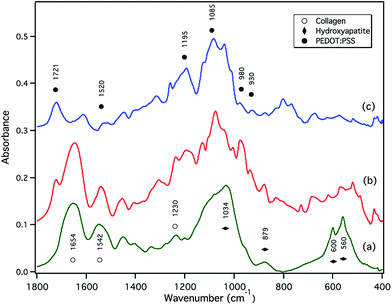 | ||
| Fig. 5 FTIR spectra of (a) collagen–calcium phosphate (0.01 M), (b) collagen–calcium phosphate (0.01 M)–PEDOT:PSS (0.045 mg mL−1) and (c) PEDOT:PSS. | ||
The FTIR spectra of four different concentrations of PEDOT:PSS incorporated collagen–hydroxyapatite composite materials are shown in Fig. S5.† When the concentration of PEDOT:PSS is too low (0.015 mg mL−1) in the electrolyte, low intensity of PEDOT:PSS peaks (at 1721, 1195 and 1085 cm−1) show up in the spectrum though collagen and hydroxyapatite peaks still dominate in the entire range. When the concentration of PEDOT:PSS is increased further (0.030, 0.045 and 0.06 mg mL−1) in the electrolyte, due to the presence of higher amount of PEDOT:PSS in the hybrid material, some PEDOT:PSS peaks overlap and start dominating the collagen and hydroxyapatite peaks (at 1230 and 1034 cm−1) though collagen amide I and amide II peaks are still predominant in those spectra.
It can be expected that a mere change in thickness of the sample could influence the intensity of absorption peaks a lot, which would make it hard to believe that that increase in the intensity of PEDOT:PSS peaks (Fig. 4 and S5†) are only due to the factor of incorporation of more PEDOT:PSS onto collagen based membranes. Therefore, in order to nullify the effect of thickness variation in peak intensity between samples, finding ratio between absorption peaks of collagen and PEDOT:PSS would provide an insight about if only the PEDOT:PSS quantity increases (or) the entire membrane thickness increases with the concentration of PEDOT:PSS. As a result, the FTIR peak area ratios between two different collagen peaks (amide I and amide II at 1654 and 1542 cm−1) and two different PEDOT:PSS peaks (at 1195 and 1721 cm−1) were calculated for the all collagen–PEDOT:PSS and collagen–hydroxyapatite–PEDOT:PSS samples and plotted against the concentration of PEDOT:PSS in Fig. 6 and S6.† The peak areas were calculated by fitting each peak separately using IgorPro 6.34A software, and then the area under each gauss-fit was measured (Fig. S7†).
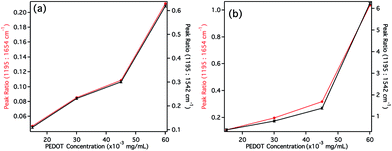 | ||
| Fig. 6 FTIR peak area ratio between PEDOT:PSS (1195 cm−1) and collagen amide (1542 and 1654 cm−1) peaks for (a) collagen–PEDOT:PSS samples and (b) collagen–hydroxyapatite–PEDOT:PSS samples. | ||
Fig. 6a and S6a† show the peak area ratios between PEDOT:PSS (1195 and 1721 cm−1) and collagen (amide I and II) for collagen–PEDOT samples at four different PEDOT:PSS concentrations. The ratio between PEDOT:PSS and collagen peaks increases with the concentration of PEDOT:PSS, confirming that PEDOT:PSS quantity increases in the collagen–PEDOT membranes for adding more quantity of PEDOT:PSS in the electrolyte. The same trend is observed on collagen–hydroxyapatite–PEDOT:PSS samples as well, where the ratio between PEDOT:PSS and collagen (amide I and II) increases with the concentration of added PEDOT:PSS (Fig. 6b and S6b†). The peak ratio between single PEDOT:PSS (1195 or 1721 cm−1) and two collagen amide peaks follow exactly same trend with the concentration of PEDOT:PSS, indicating that when the concentration of PEDOT:PSS is changed, only the ratio between the PEDOT:PSS and collagen changes, while the ratio between two collagen peaks remains same. In addition, it can be noted that PEDOT:PSS![[thin space (1/6-em)]](https://www.rsc.org/images/entities/char_2009.gif) :
:![[thin space (1/6-em)]](https://www.rsc.org/images/entities/char_2009.gif) collagen peak ratios for collagen–hydroxyapatite–PEDOT:PSS samples are always 5–10 times higher than that of collagen–PEDOT samples. This suggests that the incorporation of PEDOT:PSS is almost 5–10 times higher in collagen–hydroxyapatite samples compared to pure collagen, though the electrolyte PEDOT:PSS concentration and the applied potential were same.
collagen peak ratios for collagen–hydroxyapatite–PEDOT:PSS samples are always 5–10 times higher than that of collagen–PEDOT samples. This suggests that the incorporation of PEDOT:PSS is almost 5–10 times higher in collagen–hydroxyapatite samples compared to pure collagen, though the electrolyte PEDOT:PSS concentration and the applied potential were same.
3.2. Conductivity measurements
Fig. 7 shows the I–V plot of hydrated collagen–PEDOT:PSS samples prepared using four different concentrations of PEDOT:PSS. All samples were scanned within the same current window at the same rate. The conductivity of pure collagen membrane could not be measured (according to literature,3 the conductivity of collagen membrane is 10−13 S cm−1). However, once the PEDOT:PSS is incorporated onto the collagen membrane, it becomes electrically conducting and produces linear I–V plots even at the lowest (0.015 mg mL−1) used concentration level (Fig. 7a). When higher concentrations of PEDOT:PSS are used to make the membranes, lower potentials were observed for the same current, indicating the membrane becomes more conducting with the concentration of added PEDOT:PSS in the electrolyte. Fig. 7b shows the calculated conductivity (using eqn (1)) values against the concentration of PEDOT:PSS added in the electrolyte. As expected, the conductivity increases with the concentration (from 0.13 mS cm−1 for 0.015 mg mL−1 of PEDOT:PSS to 0.55 mS cm−1 for 0.06 mg mL−1 of PEDOT:PSS) due to the fact that the PEDOT–collagen ratio increases with the electrolyte PEDOT:PSS concentration, as shown by the FTIR.Conductivity values of collagen–HA–PEDOT:PSS membranes (hydrated), prepared using four different PEDOT:PSS concentrations are shown in Fig. 7c. As expected, the conductivity increases with the concentration of PEDOT:PSS. In addition, the conductivity of these membranes is more than ten times higher than that of collagen–PEDOT:PSS samples at all concentration levels.
This is understandable because almost 5–10 times higher quantity of PEDOT:PSS is incorporated onto collagen–hydroxyapatite membranes compared to collagen membranes, which was evident from the FTIR peak area ratio calculations (Fig. 6). As a result, the conductivity of collagen–calcium phosphate–PEDOT:PSS membranes were much higher than that of collagen–PEDOT:PSS though the electrolyte PEDOT:PSS concentration and applied potential were same. Furthermore, the relatively small error bars in Fig. 7b and c indicate that the conductivity stays within the range across the membrane, and the membranes were reproducible since the error bar was calculated based on conductivity values measured from three similarly grown samples, and on three different places each.
3.3. Scanning electron microscopy images
Scanning electron microscope images of pure collagen and collagen–PEDOT:PSS membranes prepared using four different concentrations of PEDOT:PSS are shown in Fig. 8. Fig. 8a shows the SEM image of pure collagen membrane, where collagen fibres are clearly visible and no PEDOT:PSS deposition over it. When a lower quantity of PEDOT:PSS is added in the electrolyte (0.015 mg mL−1), the PEDOT:PSS deposits randomly in few places over the collagen membrane as shown in Fig. 8b. When the concentration is increased (0.03 or 0.045 mg mL−1) further, more PEDOT:PSS is visible (white spots, as marked in Fig. 8c) over the surface of collagen membrane. For the highest concentration of PEDOT in the electrolyte, it forms a full layer of PEDOT:PSS, and covers the collagen surface completely (Fig. 8e).In the case of collagen–HA samples, a rougher HA forms on collagen surface, and collagen fibres are not visible (Fig. 9a). When PEDOT:PSS is added with collagen–HA samples, the first thing we note from some of these images is, hydroxyapatite does not cover the collagen completely and the layer of collagen is still visible in some places, though hydroxyapatite and PEDOT:PSS layers should have covered it (Fig. 9b). Also, it can be observed that PEDOT:PSS does not form a separate layer over the hydroxyapatite, as it forms over collagen membranes. Instead, the PEDOT:PSS combines with HA crystals and form a layer of HA–PEDOT:PSS on top of most of the collagen surface (Fig. 9b–e), which was confirmed through EDX as well. Though the concentration of calcium and phosphate salts are same for all those samples, it seems adding PEDOT:PSS plays a vital role in determining how the final layer of HA and PEDOT:PSS deposits. When the PEDOT:PSS concentration is increased, the size and quantity of the HA crystals tends to decrease, which may be due to the fact that the acidic PEDOT:PSS dissolves hydroxyapatite partially.27 As a result, the final layer of HA–PEDOT:PSS gets smother when highest concentration of PEDOT:PSS is used (Fig. 9e).
Fig. S8† shows the morphology difference between collagen–brushite (prepared with 0.05 M CaCl2 and KH2PO4) and collagen–HA (prepared with 0.01 M CaCl2 and KH2PO4), where brushite forms in the shape of wire like crystals, while HA crystals look like a cauliflower.
3.4. Energy dispersive X-ray spectroscopy analysis
EDX was used to analyze the two different phases of calcium phosphate that are present in the collagen–calcium phosphate–PEDOT:PSS membranes. Fig. 10a shows the EDX spectrum of a collagen–hydroxyapatite (prepared with 0.01 M CaCl2 and KH2PO4)–PEDOT:PSS (0.015 mg mL−1) membrane. It clearly shows different peaks of Ca, P (both from calcium phosphate), sulfur (from PEDOT:PSS) and Si from ITO-coated glass slide. It also shows the presence of K and Cl, which might have come from the CaCl2 and KH2PO4 salts since the sample was not rinsed after taking out from the electrolyte. Gaussian fit was performed using IgorPro software for Ca, P and S peaks in order to determine the peak areas. The peak area ratio between Ca and P was used to find out the phase of calcium phosphate, while the ratio between Ca and S was used to determine the level of PEDOT:PSS incorporation. In Fig. 10a, the peak area ratio (or atomic ratio) between the Ca and P is 1.6, indicating that the phase of the obtained calcium phosphate mineral is hydroxyapatite, for which the actual Ca![[thin space (1/6-em)]](https://www.rsc.org/images/entities/char_2009.gif) :
:![[thin space (1/6-em)]](https://www.rsc.org/images/entities/char_2009.gif) P ratio is 1.67 (Ca10(PO4)6(OH)2).28–30
P ratio is 1.67 (Ca10(PO4)6(OH)2).28–30
Fig. 10b shows the EDX spectrum of a collagen–calcium phosphate–PEDOT:PSS membrane, prepared with the addition of collagen, 0.015 mg mL−1 PEDOT:PSS and 0.05 M of CaCl2 and KH2PO4. For this sample, the peak area ratio between Ca and P is 0.9, suggesting that the obtained mineral phase is brushite, for which the actual Ca![[thin space (1/6-em)]](https://www.rsc.org/images/entities/char_2009.gif) :
:![[thin space (1/6-em)]](https://www.rsc.org/images/entities/char_2009.gif) P ratio is 1.0 (CaHPO4·2H2O).31 These EDX results of brushite and hydroxyapatite phases are consistent with the FTIR data, which are shown in Fig. S4.†
P ratio is 1.0 (CaHPO4·2H2O).31 These EDX results of brushite and hydroxyapatite phases are consistent with the FTIR data, which are shown in Fig. S4.†
EDX spectra of collagen–HA–PEDOT:PSS samples, prepared with four different concentration of PEDOT:PSS are shown in Fig. 11a. All samples were prepared using 0.01 M CaCl2 and KH2PO4, resulting in formation of hydroxyapatite phase, which can be clearly seen in the EDX spectra where all of them provided the Ca![[thin space (1/6-em)]](https://www.rsc.org/images/entities/char_2009.gif) :
:![[thin space (1/6-em)]](https://www.rsc.org/images/entities/char_2009.gif) P ratio of more than 1.5. The presence of S peaks proves the presence of PEDOT:PSS onto these samples.
P ratio of more than 1.5. The presence of S peaks proves the presence of PEDOT:PSS onto these samples.
In order to find the level of incorporation of PEDOT:PSS onto these collagen–HA–PEDOT:PSS samples, the peak area ratio between S and Ca were calculated and plotted against the PEDOT:PSS concentration (Fig. 11b). It shows that the quantity of S increases along with PEDOT:PSS concentration, showing that when the concentration of PEDOT:PSS is increased in the electrolyte, more quantity of PEDOT:PSS gets onto collagen–HA membranes. Also, from Fig. 11a, one can observe that the intensity of Ca and P peaks decrease with increasing concentration of PEDOT:PSS. This is because, acidic PEDOT:PSS can dissolve the HA crystals, resulting in lower quantity of calcium phosphate, as shown in their SEM images (Fig. 9). Moreover, the SEM pictures of all collagen–HA–PEDOT:PSS membranes show that both HA and PEDOT:PSS do not form uniform layer over the collagen membrane. Hence, the area of Ca and S peaks vary a lot across the sample, thus making the error bars so large.
The EDX spectra of collagen–PEDOT:PSS samples show only S peak (Fig. S9†), making it very hard to interpret the data. Since there is no other peak present to compare the area of S peak, the level of PEDOT:PSS incorporation onto collagen membranes can not be verified with EDX data alone.
3.5. DSC thermograms
DSC thermograms of collagen and collagen–PEDOT:PSS membranes were taken in order to find the effect of incorporation of PEDOT:PSS on the denaturation temperature (Td) of collagen. When heat is applied, the denaturation of collagen occurs because of the disintegration of its triple helix structure into random coils due to the rupture of H-bonds between peptide strands.32 Earlier studies have shown that reinforcements such as hyaluronan and chitosan can enhance the thermal transition temperature collagen.1 As seen in Fig. 12a, the denaturation temperature of electrochemically aggregated pure collagen membrane is ∼161 °C, which gradually increases up to 178 °C for the addition of 0.060 mg mL−1 of PEDOT:PSS in the electrolyte. Though the mechanism behind this is not well understood, it can be attributed to the fact that PEDOT:PSS is more thermally stable than collagen. PEDOT:PSS is thermally stable up to 260 °C (except the solvent/water loss), and beyond that the PSS starts degrading due to the rupture of sulfonate from styrene. The backbone of PEDOT:PSS polymer starts rupturing only from 350 °C onwards.33 Therefore, adding more thermally stable PEDOT:PSS onto collagen membrane may enhance its thermal stability (by forming a chemical link, if possible), thus increasing its denaturation temperature. Generally the denaturation of collagen can occur as early as at 36 °C if the collagen (type I) is fully hydrated, or go beyond 200 °C if it is dehydrated completely.24 Therefore, it is reasonable to expect that the denaturation of our collagen and collagen–PEDOT:PSS samples occur at around 161 to 180 °C since these membranes are neither fully-hydrated nor fully-dehydrated.Fig. 12b shows the DSC thermograms of collagen–calcium phosphate (0.01 M) membrane and collagen–calcium phosphate–PEDOT:PSS hybrid composites, prepared using four different concentrations of PEDOT:PSS. The denaturation temperature of collagen–HA (164 °C) is slightly higher than that of pure collagen membrane, indicating that the HA crystals had interacted with the collagen fibers and formed more stable, mineralized collagen without affecting much of its original triple-helix secondary structure.34 The denaturation endotherm of collagen–hydroxyapatite, obtained at 164 °C matches well with the denaturation temperature of mineralized collagen found on the bone.35 The addition of PEDOT:PSS onto collagen–calcium phosphate has minimal effect on its denaturation temperature. This may be because PEDOT:PSS layer forms over hydroxyapatite, not directly on the collagen membrane. As a result, the denaturation of collagen may not be influenced by the incorporation of PEDOT:PSS since the collagen does not form any chemical/physical interaction with PEDOT:PSS directly. The slight change (164 to 172 °C) in the denaturation temperature can be attributed to the fact that hydroxyapatite generally does not cover the entire surface of collagen, and there is high change for the PEDOT:PSS to get into those areas and form a link with collagen, thus affecting its denaturation temperature slightly. In addition, the denaturation peaks of all hydroxyapatite incorporated composites (Fig. 12b) are broader compared to that of collagen and collagen–PEDOT samples (Fig. 12a).
4. Conclusions
In this work, we have shown that a conducting polymer (PEDOT:PSS) can be electrochemically incorporated onto collagen and/or collagen–hydroxyapatite composites. FTIR spectra clearly indicate that when the concentration of PEDOT:PSS in the electrolyte is varied, it alters the quantity of PEDOT:PSS on both collagen and collagen–calcium phosphate. Therefore, by varying the electrolyte composition it is possible to make the composite membrane either as highly conducting (with more PEDOT:PSS) or more biocompatible (with more collagen and/or hydroxyapatite). Though there have been some reports in which protein–conducting polymer composites (collagen–PEDOT,16 collagen–polypyrrole,7 hyaluronic acid–polypyrrole6,36 and nerve growth factor–polypyrrole5) have been synthesized for electrical stimulation purposes, those methods use protein as a dopant for the conducting polymer to enhance their biocompatibility. For example, Li et al.7 have used collagen and poly[sodium 4-(3-pyrrolyl)butanesulfonate as dopants for polypyrrole to synthesize a hybrid biomaterial gel. Though the electrical conductivity of these materials was found to be good (10−2 S cm−1), the collagen content on these membranes ranged from 11 wt% to 38 wt%, which would make the hybrid membrane less biocompatible. On the other hand, the method reported herein allows varying amounts of PEDOT:PSS to be incorporated onto highly biocompatible collagen (or) collagen–calcium phosphate to make membrane electrically conductive (to perform stimulation) without compromising its biocompatibility. Another advantage of our method compared to conventional electrochemical method is that the protein–conducting polymer composite does not need an electrode as a substrate since it forms as a membrane in the middle of the electrochemical cell (not over the electrode surface like any electrochemical deposition methods), requiring no effort to remove it from the metal substrate before performing cell culture studies. Moreover, the chemical synthesis to develop blends of collagen and poly-o-ethoxyaniline (POEA)3 requires a well controlled environment (such as pH ∼ 3.5) in order to form electrostatic and H-bond interaction between collagen and POEA groups, and even 50% of POEA produces the membrane with a conductivity of 10−5 S cm−1, which is ∼20–50 times lesser than the samples prepared by our method, using much lower concentrations of PEDOT:PSS. In some cases, carbon nanotube (CNT) was also used to make a composite with polylactic acid (PLA) to perform electrical stimulation on osteoblasts.4 However, this method requires rigorous synthesis such as heating up to 130 °C for solvent evaporation and vacuum drying for 24 h, which may not be suitable if proteins such as collagen need to be used.Besides collagen–PEDOT, it has also been shown that PEDOT:PSS can be incorporated electrochemically on to collagen–calcium phosphate mineral composites at different ratios. To the best of our knowledge, there are no reports on the direct synthesis of conducting biomineral composites though it is shown that electrical stimulation greatly enhances the amount of hydroxyapatite (>200%) deposited on the PLA–CNT composite.4 We have already reported that the cells grow very well on our electrochemically aggregated collagen membrane than some commercially available collagen monomers,13 and we expect that incorporating a biocompatible PEDOT37 on it shouldn't affect its biocompatibility much.
Acknowledgements
We thank our funding agencies: the Natural Sciences and Engineering Research Council (NSERC) of Canada, the Canada Foundation for Innovation (CFI), the Manitoba Research and Innovation Fund and the University of Manitoba. Additional financial support was provided in part from the Canada Research Chairs (CRC) Program. We thank Dr Michael McDonald and Dr Ravinder Sidhu for assistance with operating four-point probe, SEM and EDX instruments.Notes and references
- Y.-C. Lin, F.-j. Tan, K. G. Marra, S.-S. Jan and D.-C. Liu, Acta Biomater., 2009, 5, 2591–2600 CrossRef CAS PubMed.
- M. R. Kumar, E. F. S. Merschrod and K. M. Poduska, Cryst. Growth Des., 2011, 11, 26–28 CAS.
- M. A. Piza, C. J. L. Constantino, E. C. Venancio and L. H. C. Mattoso, Polymer, 2003, 44, 5663–5670 CrossRef CAS.
- P. R. Supronowicz, P. M. Ajayan, K. R. Ullmann, B. P. Arulanandam, D. W. Metzger and R. Bizios, J. Biomed. Mater. Res., 2002, 59, 499–506 CrossRef CAS PubMed.
- D.-H. Kim, S. M. Richardson-Burns, J. L. Hendricks, C. Sequera and D. C. Martin, Adv. Funct. Mater., 2007, 17, 79–86 CrossRef CAS PubMed.
- J. H. Collier, J. P. Camp, T. W. Hudson and C. E. Schmidt, J. Biomed. Mater. Res., 2000, 50, 574–584 CrossRef CAS.
- H. C. Li and E. Khor, Macromol. Chem. Phys., 1995, 196, 1801–1812 CrossRef CAS PubMed.
- K. C. Donavan, J. A. Arter, G. A. Weiss and R. M. Penner, Langmuir, 2012, 28, 12581–12587 CrossRef CAS PubMed.
- B. Teixeira-Dias, L. J. del Valle, F. Estrany, J. F. Mano, R. L. Reis and C. Aleman, Macromol. Mater. Eng., 2012, 297, 359–368 CrossRef CAS PubMed.
- C. E. Schmidt, V. R. Shastri, J. P. Vacanti and R. Langer, Proc. Natl. Acad. Sci. U. S. A., 1997, 94, 8948–8953 CrossRef CAS.
- H. P. Wiesmann, M. Hartig, U. Stratmann, U. Meyer and U. Joos, Biochim. Biophys. Acta, Mol. Cell Res., 2001, 1538, 28–37 CrossRef CAS.
- M. R. Kumar, E. F. S. Merschrod and K. M. Poduska, in Advances in Bioceramics and Biotechnologies, ed. R. Narayan and J. McKittrick, 2010, vol. 218, pp. 3–13 Search PubMed.
- R. N. Fong, L. A. McDuffee, B. P. E. Gonzalez, M. R. Kumar, E. F. S. Merschrod and K. M. Poduska, Macromol. Biosci., 2013, 13, 348–355 CrossRef PubMed.
- R. Gendron, M. R. Kumar, H. Paradis, D. Martin, N. Ho, D. Gardiner, E. F. S. Merschrod and K. M. Poduska, Macromol. Biosci., 2012, 12, 360–366 CrossRef CAS PubMed.
- R. A. Green, N. H. Lovell, G. G. Wallace and L. A. Poole-Warren, Biomaterials, 2008, 29, 3393–3399 CrossRef CAS PubMed.
- Y. Xiao, C. M. Li, S. Wang, J. Shi and C. P. Ooi, J. Biomed. Mater. Res., Part A, 2010, 92, 766–772 CrossRef PubMed.
- H. R. Baker, E. F. Merschrod and K. A. Poduska, Langmuir, 2008, 24, 2970–2972 CrossRef CAS PubMed.
- Y. W. Fan, K. Duan and R. Z. Wang, Biomaterials, 2005, 26, 1623–1632 CrossRef CAS PubMed.
- M. R. Kumar, E. F. S. Merschrod and K. M. Poduska, Biomacromolecules, 2009, 10, 1970–1975 CrossRef CAS PubMed.
- J.-I. Youn and T. E. Milner, Laser. Med. Sci., 2008, 23, 229–235 CrossRef PubMed.
- B. D. Vidal and M. L. S. Mello, Micron, 2011, 42, 283–289 CrossRef CAS PubMed.
- S. Nagarajan, J. Kumar, F. F. Bruno, L. A. Samuelson and R. Nagarajan, Macromolecules, 2008, 41, 3049–3052 CrossRef CAS.
- M. Trpkovska, B. Soptrajanov and P. Malkov, J. Mol. Struct., 1999, 481, 661–666 CrossRef.
- V. Samouillan, F. Delaunay, J. Dandurand, N. Merbahi, J.-P. Gardou, M. Yousfi, A. Gandaglia, M. Spina and C. Lacabanne, J. Funct. Biomater., 2011, 2, 230–248 CrossRef CAS PubMed.
- I. Rehman and W. Bonfield, J. Mater. Sci.: Mater. Med., 1997, 8, 1–4 CrossRef CAS.
- M. S. A. Johnsson and G. H. Nancollas, Crit. Rev. Oral Biol. Med., 1992, 3, 61–82 CAS.
- E. I. F. Pearce, J. Dent. Res., 1988, 67, 1056–1058 CrossRef CAS PubMed.
- S. Joschek, B. Nies, R. Krotz and A. Gopferich, Biomaterials, 2000, 21, 1645–1658 CrossRef CAS.
- D. Luna-Zaragoza, E. T. Romero-Guzmán and L. R. Reyes-Gutiérrez, J. Miner. Mater. Charact. Eng., 2009, 8, 591–609 Search PubMed.
- J. A. Juhasz, S. M. Best, A. D. Auffret and W. Bonfield, J. Mater. Sci.: Mater. Med., 2008, 19, 1823–1829 CrossRef CAS PubMed.
- P. Delvasto, A. Valverde, A. Ballester, J. M. Igual, J. A. Munoz, F. Gonzalez, M. L. Blazquez and C. Garcia, Soil Biol. Biochem., 2006, 38, 2645–2654 CrossRef CAS PubMed.
- Y. Li, Y. Li, Z. Du and G. Li, Thermochim. Acta, 2008, 469, 71–76 CrossRef CAS PubMed.
- B. Friedel, P. E. Keivanidis, T. J. K. Brenner, A. Abrusci, C. R. McNeill, R. H. Friend and N. C. Greenham, Macromolecules, 2009, 42, 6741–6747 CrossRef CAS.
- A. Akkouch, Z. Zhang and M. Rouabhia, J. Biomed. Mater. Res., Part A, 2011, 96, 693–704 CrossRef PubMed.
- R. J. González-Paz, J. L. Feijoo, K. Noris-Suárez, A. M. Ferreira and G. González, Caracterización mediante FTIR y DSC de la interacción colágeno—hidroxiapatita, Margarita Island, Venezuela, 2008 Search PubMed.
- J. M. Pelto, S. P. Haimi, A. S. Siljander, S. S. Miettinen, K. M. Tappura, M. J. Higgins and G. G. Wallace, Langmuir, 2013, 29, 6099–6108 CrossRef CAS PubMed.
- M. Asplund, E. Thaning, J. Lundberg, A. C. Sandberg-Nordqvist, B. Kostyszyn, O. Inganas and H. von Holst, Biomed. Mater., 2009, 4, 045009 CrossRef CAS PubMed.
Footnotes |
| † Electronic supplementary information (ESI) available. See DOI: 10.1039/c5ra07500a |
| ‡ Current address: Department of Chemistry, Florida Institute of Technology, Melbourne, FL 32901. |
| This journal is © The Royal Society of Chemistry 2015 |

